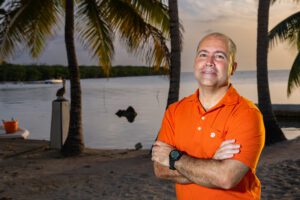A Clemson University undergraduate student’s research could help efforts to conserve an important deep-sea coral imperiled by a changing global climate and human activities like fishing and oil exploration.
Joshua Tucker, a senior microbiology major, developed the first genomic portrait of the reef-building coral Madracis myriaster, known as the “fluted finger coral.”
M. myriaster is one of the most important reef-building corals in deep-water habitats of the Caribbean Sea.
“It is very important that we understand these deep-sea corals well because they are crucial to the health of their community, yet are so fragile and so slow-growing that if damage occurs due to anthropogenic activity such as fishing or oil extraction, it can lead to some serious downstream effects,” said Tucker, who is a Goldwater Scholar.

At depths of 120 to 1,200 meters (about 400 to 4,000 feet), M. myriaster shares deep rocky seabeds with sea anemones, other corals and algae. These reefs serve as a refuge to many species of fishes and invertebrates, including crustaceans, polychaetes and echinoderms. Despite being a common species in deep habitats, M. myriaster is difficult to identify and it is often confused with other closely related deep-water and shallow-water corals.
Tucker created a “genomic portrait” of the deep-water azooxanthellate reef-building stony coral by characterizing its mitochondrial genome.
Using a fragment of a M. myriaster specimen from the reference collection of Cnidarians at the Marine Natural History Museum of Colombia and a low-coverage short read sequencing strategy, the study estimated the genome size, identified repetitive genome content, annotated and quantified repetitive elements, assembled the nuclear RNA gene operon and characterized in detail the mitochondrial genome ofM. myriaster.
Bigger picture
“It’s hard to say how imperiled a species is if you don’t even know where it resides, how widespread it is, orits prevalence. It’s really difficult to determine the health of something at an overall species level without knowing the bigger picture,” Tucker said. “This research is trying to characterize the elements that will help better our understanding of this species so that we can take action if necessary.”
Tucker’s research started with a Marine Conservation and Genetics Creative Inquiry course led by Associate Professor of Biological Sciences Antonio Baeza. Being able to work on a research project that would have direct impact “was enough to rope me in,” Tucker said. After spending a semester learning about bioinformatic tools, Tucker was able to use that knowledge on a project that had real-world applications.
“It was amazing to be able to take what I’ve learned and be able to apply that knowledge to generate a study with real-world impact,” Tucker said. “There’s so many things impacting corals right now that are causing them to be in peril. My main hope is that this work genuinely does help make conservation efforts easier for scientists and governments.”

The findings will improve scientists’ understanding of the biology, conservation and management of the coral in Colombia and the entire Caribbean basin, Baeza said.
“We know so little about corals. We know even less about deep-water species,” he said.
With the information from Tucker’s study, scientists will be able to conduct bioprospecting and biomonitoring of this species using indirect sampling strategies like environmental DNA, Baeza said.
In the past, scientists had to utilize robots with cameras to find where populations of these imperiled deep-sea corals were located. Now, they can take a water sample, extract DNA, assemble sequence fragments and compare them to reference mitochondrial genomes to determine the presence or absence of this or other corals in a particular region of the Caribbean, Baeza said.
Long-term response
In addition, the genomic resources generated can be used to determine how the corals are responding to long-term stress.
Stressors can include those to which shallow-water coral are exposed — such as acidification of ocean waters and increased temperatures — and stressors that affect only deep-sea ecosystems, like fishing and oil exploration, Tucker said.
“Corals are foundational to the entire marine ecosystem since both shallow reefs and deep-sea reefs create some of the most productive and species-rich environments on the planet. What drew me toward the deep-water side of things is that we know so little about deep-sea reefs that any information could go a long way,” said Tucker, who plans to go to medical school.
Scientific growth
Tucker said the research project allowed him to grow as a scientist.
“It was a lot of trial and error. There was a whole process of learning the background of the animal, learning about the tools that I could use, learning why a certain tool didn’t do what I thought it would do andeventually figuring out why the result was different than what is typically expected,” he said. “The trial and error process was something special and was really transformative in terms of how I view science and the flow of research.”
Detailed findings can be found in the paper titled “A first genomic portrait of the deep-water azooxanthellate reef-building coral Madracis myriaster: genome size, repetitive elements, nuclear RNA gene operon, mitochondrial genome and phylogenetic placement in the family Pocilloporidae.” The paper was published in the prestigious journal Coral Reef.
Researchers from Chile, Colombia and the U.K. were also involved in the research.
Get in touch and we will connect you with the author or another expert.
Or email us at news@clemson.edu

